Accepted Scientific Name: Sesuvium portulacastrum L.
Syst. Nat., ed. 10. 2: 1058. 1759 [7 Jun 1759] L.

Halimus portulacastrum (Sesuvium portulacastrum) Photo by: Forest Starr & Kim Starr
Leaves and flowers at Kanaha Beach, Maui, Hawaii (USA). February 06, 2001.
Origin and Habitat: It is a pantropic halophyte found on all tropical and subtropical shores of both hemispheres comprising Africa, Asia, Australia, North America and South America, and has naturalised in many places where it is not indigenous.
Habitat: It is a common a groundcover that grows an sandy clay, limestone and sandstone soils with or without organic or humusy top layer both wet or desiccated, in foreshore sand-dunes down to the upper littoral, margins of coastal wetlands, tidal flats, salt marshes, edges of salt-lagoons, ballasts and waste grounds.
Altitude range: 0-5 m.
Synonyms:
See all synonyms of Sesuvium portulacastrum
back
Accepted name in llifle Database:Sesuvium portulacastrum L.Syst. Nat., ed. 10. 2: 1058. 1759 [7 Jun 1759]Synonymy: 26
back
Common Names include:
ENGLISH: Cenicilla, Samphire, Seaside Purslane, Shoreline purslane, Shoreline sea-purslane, Cencilla
AKAN-FANTE (Fante): Kleŋme (Ghana), Gbekebii amada (Ghana), Eŋmebi (Ghana), Mbrenkyi (Ghana)
BALANTA: Burunquè (Guinea Bissau), Bóssaha (Guinea Bissau)
BANYUN ( (Banyun, Nyun, or Bainouk): Dalémukor (Senegal)
CHINESE (中文): 海马齿
FRENCH (Français): Pourpier de mer, Pourpier maritime
GBE-VHE: Solĩ (Ghana)
HAWAIIAN (ʻŌlelo Hawaiʻi): Akulikuli, ʻĀkulikuli
MANDINKA or MANDING ((Mandi\'nka kango لغة مندنكا): Sâbańańi (Senegal)
MANINKA (Malinke): Dalôga (Senegal), Roltakar (Senegal), Sâbana (Senegal), Samba gnagna (Senegal), Sambaniani (Senegal)
PEPEL: Ombuntutchus (Guinea Bissau)
PORTUGUESE (Português): Beltroega de praia
RUSSIAN (Русский): Сезувиум портулаковидный
SERER-NON (Nyominka): Isâbańańa (Senegal), Sâbana (Senegal)
SOCE (Socé ): Sabańańi (Senegal)
TAGALOG: Dampalit
TEMNE or THMNE (KʌThemnɛ): A-ret (Sierra Leone)
THAI (ภาษาไทย): ผักเบี้ยทะเล
TONGAN (Faka-Tonga): Kihikihimaka
VIETNAMESE (Tiếng Việt): Rau heo, Sam biển, Hải châu
WOLOF (Wolof): Horomdâta (Senegal), Kamina (Senegal)
Description: Sesuvium portulacastrumSN|23810]]SN|23810]] is a fleshy prostrate to suberect perennial psammophile herb up to 30 cm tall, forming mats to 2 m diameter; all parts glabrous. It is very variable.
Stems: Thick, smooth, branched, rooting at nodes up to 1 m long.
Leaves: Sessile or subsessile, opposite, smooth, fleshy, oblanceolate to elliptic-ovate, 10–70 mm long, 2–25 mm wide, medium green turning red or yellow with age. Those grown in open or full sun areas usually have redder leaves than do shaded plants. Leaves narrow into a very short petiole, base with scarious margins clasping stem and connate with that of the opposing leaf, tip rounded, succulent with convex lower surface.
Flower: Solitary, semi-showy, pedicels 3–15(-20) mm long, thicker near tip. Perianth lobes (tepals) ovate to lanceolate (3-)7-10(-12) mm long, green on the outside, pink, red or purplish on the inside, about 3 times as long as tube, triangular, unequal, acute with subapical apiculus with subapical abaxial appendages. Stamens many 30, free. Ovary (2–)3(–4)-celled, pistil 5-carpellate; ovary 5-loculed; styles 5. The flowers are hermaphrodite (have both male and female organs)
Flowering Season:All year.
Fruit: Inconspicuous conical capsules with 30–60 seeds.
Seeds: Black, shiny, smooth, 1,2-1,6 mm long.
Bibliography: Major references and further lectures
1) Forest & Kim Starr “Sesuvium portulacastrum (Akulikuli, sea purslane)”. Plants of Hawaii. <http://www.starrenvironmental.com>. Downloaded on 20 August 2014.
2) M. G. Gilbert "Flora Somalia" Vol 1 1993
3) C. Jeffrey "Flora of Tropical East Africa" page 1 1961
4) Burkill, H.M. "The useful plants of west tropical Africa" Vol 1 1985
5) Wayne R. Ferren Jr. "Flora of North America" Vol 4
6) Wikipedia contributors. "Sesuvium portulacastrum." Wikipedia, The Free Encyclopedia. Wikipedia, The Free Encyclopedia, 8 Aug. 2014. Web. 23 Sep. 2014
7) Prescott, A. and Venning, J. "Aizoaceae". Flora of Australia 4. Canberra: Australian Government Publishing Service. 1984
8) Chandrasekaran M., Senthilkumar A., Venkatesalu V "Antibacterial and antifungal efficacy of fatty acid methyl esters from the leaves of Sesuvium portulacastrum L. ". European Review for Medical and Pharmacological Sciences. 15 (7) (pp 775-780), 2011
9) G. J. H. Grubben "Vegetables" PROTA, 2004
10) D. Messedi, N. Sleimi & C. Abswlly "Some phisiological and biochemical aspects of salt tolerance of Sesuvium portulacastrum" in: Helmut Lieth, Marina Mochtchenko "Cash Crop Halophytes: Recent Studies: Ten Years After Al Ain Meeting" Springer Science & Business Media, 01/Jan/2003
11) Richard Stephen Felger "Flora of the Gran Desierto and R’o Colorado of Northwestern Mexico" University of Arizona Press, 2000
12) Dr. John Anurag Panga "Plants of AMS Garden: A Garden in the Arabian Deserts of Dubai" Xlibris Corporation, 26/Aug/2014
13) Chedly Abdelly, Münir Öztürk, Muhammad Ashraf, Claude Grignon "Biosaline Agriculture and High Salinity Tolerance" Springer Science & Business Media, 18/Apr/2008
14) Heidrun E.K. Hartmann "Illustrated Handbook of Succulent Plants: Aizoaceae F-Z" Springer Science & Business Media, 2002
15) Ira Loren Wiggins, Duncan M. Porter, Edward F. Anderson "Flora of the Galápagos Islands" Stanford University Press, 1971
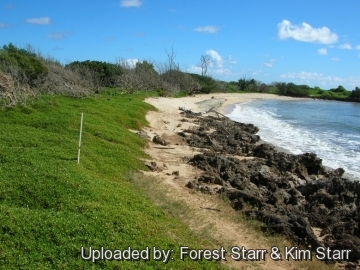 Habit at Mokuauia, Oahu, Hawaii (USA). February 22, 2005. (Sesuvium portulacastrum) Photo by: Forest Starr & Kim Starr
Habit at Mokuauia, Oahu, Hawaii (USA). February 22, 2005. (Sesuvium portulacastrum) Photo by: Forest Starr & Kim Starr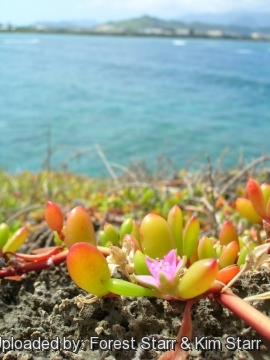 Flower at Kekepa, Oahu, Hawaii (USA). April 18, 2005. (Sesuvium portulacastrum) Photo by: Forest Starr & Kim Starr
Flower at Kekepa, Oahu, Hawaii (USA). April 18, 2005. (Sesuvium portulacastrum) Photo by: Forest Starr & Kim Starr Habit at Popoia, Oahu, Hawaii (USA). February 23, 2005. (Sesuvium portulacastrum) Photo by: Forest Starr & Kim Starr
Habit at Popoia, Oahu, Hawaii (USA). February 23, 2005. (Sesuvium portulacastrum) Photo by: Forest Starr & Kim Starr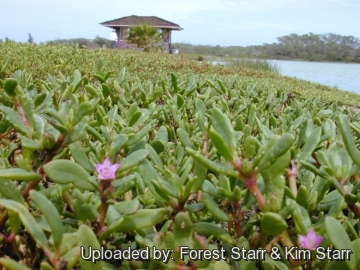 Habit at Kanaha pond, Maui, Hawaii (USA). February 09, 2001. (Sesuvium portulacastrum) Photo by: Forest Starr & Kim Starr
Habit at Kanaha pond, Maui, Hawaii (USA). February 09, 2001. (Sesuvium portulacastrum) Photo by: Forest Starr & Kim Starr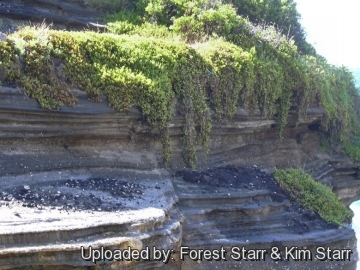 Habit at Koko Head lookout, Oahu, Hawaii (USA). July 11, 2004. (Sesuvium portulacastrum) Photo by: Forest Starr & Kim Starr
Habit at Koko Head lookout, Oahu, Hawaii (USA). July 11, 2004. (Sesuvium portulacastrum) Photo by: Forest Starr & Kim Starr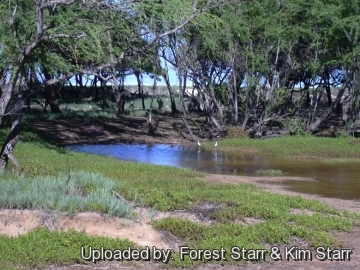 Near wetland with stilts at Kanaha Beach, Maui, Hawaii (USA). January 10, 2004. (Sesuvium portulacastrum) Photo by: Forest Starr & Kim Starr
Near wetland with stilts at Kanaha Beach, Maui, Hawaii (USA). January 10, 2004. (Sesuvium portulacastrum) Photo by: Forest Starr & Kim Starr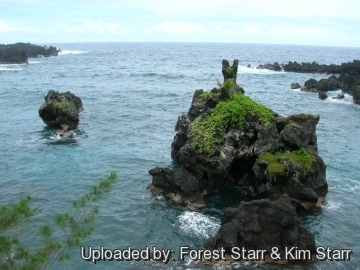 Habit view islets at Waianapanapa, Maui, (USA). April 22, 2006. (Sesuvium portulacastrum) Photo by: Forest Starr & Kim Starr
Habit view islets at Waianapanapa, Maui, (USA). April 22, 2006. (Sesuvium portulacastrum) Photo by: Forest Starr & Kim StarrSend a photo of this plant.The gallery now contains thousands of pictures, however it is possible to do even more. We are, of course, seeking photos of species not yet shown in the gallery but not only that, we are also looking for better pictures than those already present.
Read More... Cultivation and Propagation: The plants in this genus represent some of the more easily cultivated succulent species.
Water: Water moderately from early spring to the end of autumn, and keep the compost quite dry when the plants are dormant watering, only if the plant starts shrivelling (, but they will generally grow even in winter if given water). Outdoors does not require any supplemental water once established.
Soils: It grow in dry, moist or wet soils and can even grow directly in water. It adapt to almost every kind of substrate comprising: clay, sand, cinder, limestone, organic and coral either acidic, neutral and basic (alkaline).
Fertilization: It has low nutritional requirements and grows well in nutrient poor soils. But for an healthy cultivation follow a low fertilizing regiment (but this is not necessary for plants in water features) An application slow release fertilizer with minor elements every six months. Foliar feeding with a water-soluble or an organic fertilizer at one-third to one-fourth the recommended strength monthly has proved beneficial.
Exposure: Full sun is optimal but tolerates some shading for part of the day.
Salt Tolerance: It tolerates flooding by salt water and is a pioneer species that grows in unconsolidated substrate in direct salt wind and spray.
Hardiness: In areas prone to frost, grow in an intermediate greenhouse or conservatory, in pots of cactus compost. Provide maximum light all the year round.
Maintenance: Prune it to keep confined to growing areas.
Pests & disease: This prostrate groundcover is prone to slug and snail attacks.
Propagation: Seeds or cuttings. Seeds can be sown in early to mid-spring and germinated in heated humid environment. Alternatively, use stem cuttings taken towards the end of summer.
Uses:
A) Environmental recovery: Sesuvium portulacastrumSN|23810]]SN|23810]] is one of the most salt-tolerant of all coastal plants and is an important sand stabilizer in the pioneer zone of beach dunes and can tolerate occasional flooding by sea water.
B) Gardening: It is an easy-to-grow groundcover, ideal for low-maintenance and water-wise gardens, for beach areas, saline soils, xeric landscaping and around water features where it does tolerate some foot traffic. But like most plants constant foot traffic will eventually cause irreparable damage. It is also a nice container plant that should be given full sun and regular watering.
C) Food: The plant is eaten in all parts of the West African coast and in many other tropical tropical parts. Thorough washing is necessary to remove excess of salt and perhaps better still boiling in two or three changes of water. The leaves have the acidulous flavour of sorrel and have been used as a source of vitamin C.
D) Fodder: Sheep and goats graze it, and it provides a good salty pasturage for camels in Mauritania.
E) Medicine: The plant extract shows antibacterial and anticandidal activities and moderate antifungal activity.

















